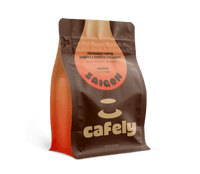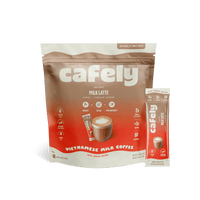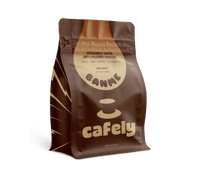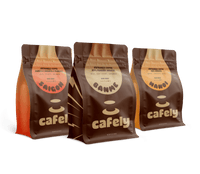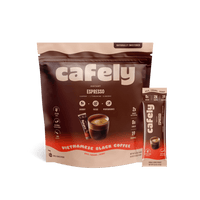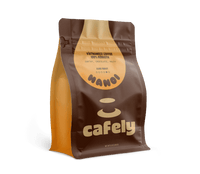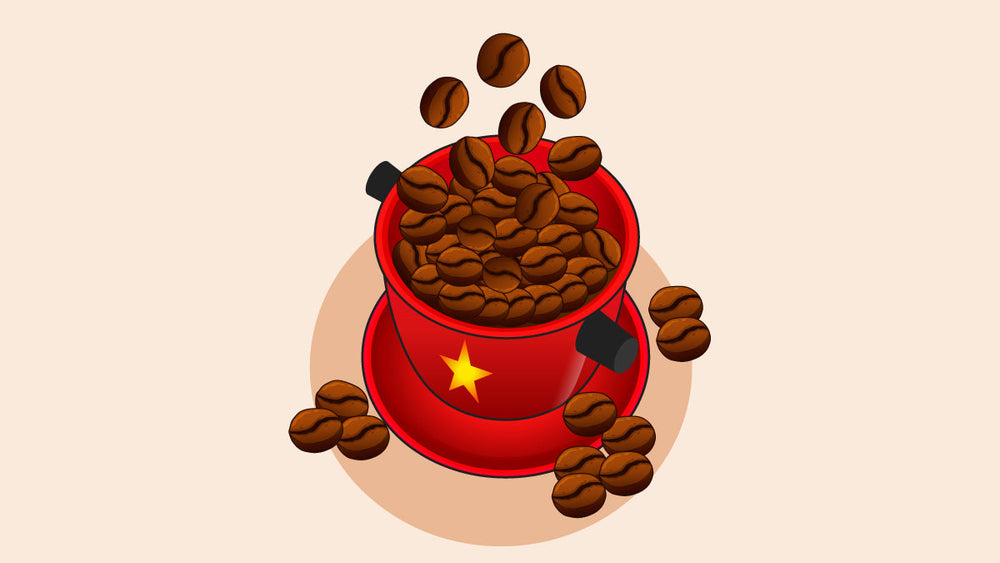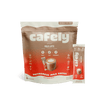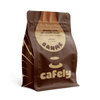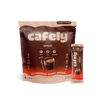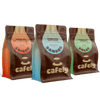The phrase “strong coffee” means something different to everybody. It can refer to the flavor, the concentration of the brew, the caffeine content, or any combination of the above. And what one person considers strong, another might consider average or even weak.
Still, there’s a general agreement that some coffees are undeniably stronger than others. For example, Turkish coffee and Vietnamese coffee are both known for being the strongest coffees in the world.
Here, we’ll examine what makes Vietnamese coffee so strong and offer some steps you can take to make it even stronger.
Factors That Makes Vietnamese Coffee So Strong

There are four key factors that work together to make Vietnamese coffee some of the strongest in the world:
1. Robusta Coffee Beans
Coffea robusta beans are usually used in instant coffee because they have a strong flavor and are cheaper to produce. They receive unfair criticism as the less popular relative of the widely-known Arabica coffee bean but are gaining popularity among those who know good robusta beans give a great caffeine kick and a deep, bold flavor.
You need to have a high-quality robusta bean like Cafely’s HaNoi when making traditional Vietnamese-style coffee. It contains almost double the amount of caffeine in arabica, giving it an intense flavor with notes of cocoa, caramel, and even whiskey. Some people describe an earthy taste from the high caffeine content and volcanic soil in which Vietnamese robusta is grown.
Robusta is much easier to grow than arabica coffee. It’s hardy and tolerates hot climates and diverse environmental conditions. It particularly likes lowland areas, unlike arabica, which needs high altitudes to survive.
It truly is a “robust” plant — it’s less susceptible to disease or pests and yields more beans than arabica. However, the soil needs to be nutrient-rich and fertile if you want the beans to be high-quality.
2. Strong Dark Roast
The roasting stage develops the overall aroma and flavor of the coffee beans. The darker it’s roasted, the stronger the taste.
Robusta beans are dark-roasted, giving them an oily consistency and a thick crema when brewed for espresso coffee. Their exposure to a high temperature for an extended period increases the oil content and decreases the moisture. The oil gives the coffee a thicker consistency and a stronger, full-bodied flavor.
Robusta beans are usually roasted with a drum, hot air, or fluid bed. Each style has pros and cons, though drum roasting is the most popular. As its name suggests, this involves placing the coffee beans into a large drum over a heat source and roasting the beans as they sporadically come into contact with the hot metal. Hot air roasting produces a less bitter coffee, and fluid bed roasting gives the most even results. However, the temperature, roasting time, and the quality of the beans affect the aromas and flavors.
Robusta beans contain minimal sugar and fats, so it’s common for roasters to add sugar and butter during the process to counter their natural bitterness. In Vietnam, you’ll find additions like chicory powder, rice liquor, cocoa, salt, vanilla, whiskey, or even fish oil to alter the taste.
3. Long Extraction Times
The longer your coffee takes to brew, the stronger it will be. Slow brewing methods like the traditional Vietnamese phin filter extract more of the active compounds from coffee — making a stronger, more robust cup.
When it comes to brewing strong coffee, patience is a virtue.
Coffee aficionados know the best beverages are worth waiting for. Not only is the slow-drip method visually appealing, but it also produces a drink that has less acidity and does not compromise on flavor.
What Makes Coffee Strong or Weak?
Coffee beans are full of compounds that provide their distinct flavor and aroma.
These compounds are extracted from the bean during the brewing process; different styles of brewing are better for pulling out different types of compounds.
A very strong coffee contains a full extraction of coffee, while weaker brews only extract the lighter elements.
The best way to measure the amount of compounds extracted into the final cup is to measure total dissolved solids (TDS) — this measurement quantifies the amount of particles in the final brew to determine how strong it is [1,2]
How to Make Your Vietnamese Coffee Even Stronger?

Vietnamese coffee is already very strong, but there are ways to make it even stronger:
- Use a higher coffee-to-water ratio — The simplest way to boost your brew is to use more coffee.
- Use 100% peaberry robusta — Our BanMe coffee is made exclusively with peaberry coffee (a mutated bean that contains just one seed instead of two and nearly 30% more caffeine than typical robusta).
- Mix other ingredients — Coca leaf, yerba mate, guarana, and ginseng are all great additions to strong coffee that can make it even stronger.
- Add a shot of espresso — While far from “traditional” some people like to give their coffee some added kick by mixing in a shot of espresso.
- Increase brewing time — The longer you steep your coffee, the stronger it’s going to be. The tradeoff here is that some of the heavier elements that diffuse later in the brew may impart a bad taste.
- Add other sweeteners — Strong Vietnamese coffee usually combines coffee with a source of sweetness to match it. Try experimenting with egg foam and make Vietnamese Egg Coffee, sweetened condensed milk, or agave syrup to counter the bitter edges of strong coffee.
FAQs: Vietnamese Coffee
We hope this guide has answered some of your questions about why Vietnamese coffee is so strong. Check out our FAQs for further insights into your favorite cup of joe.
1. Why is robusta coffee so much stronger than arabica coffee?
Robusta coffee is much stronger than arabica coffee because it has almost twice the caffeine content, which also affects the overall flavor.
2. Where does the robusta bean grow?
Robusta thrives in various environments. It thrives at low altitudes and grows well in hot, humid climates. It is easier to grow than arabica because it is hardy and doesn’t require special conditions.
3. What is crema?
Crema is the reddish-brown foam that sits on top of your espresso and comes from the air bubbles and soluble oils. There might be some discrepancy about whether it’s a good thing, but it’s actually a sign of high-quality, well-ground coffee.
4. What are the different types of robusta coffee beans?
There are two types of robusta coffee beans,Nganda and Erecta. Nganda means wide-spreading shrub, and Erecta means a tall-growing shrub. Though the plants are different, the beans have similar flavor profiles.
References
- Cordoba, N., Fernandez-Alduenda, M., Moreno, F. L., & Ruiz, Y. (2020). Coffee extraction: A review of parameters and their influence on the physicochemical characteristics and flavor of coffee brews. Trends in Food Science & Technology, 96, 45-60.
- Walston, J. D., Short, D. L., & Badar, M. A. (2022). An experimental design on coffee extraction factors impacting the measurable percent of total dissolved solids in solution. Asia-Pacific Journal of Management Research and Innovation, 18(3-4), 120-130.
